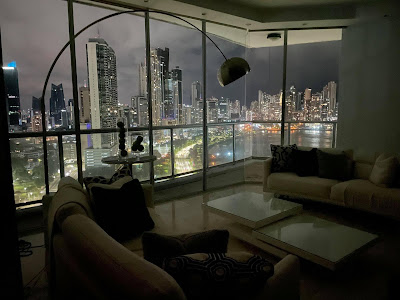On Sept. 1, 2021, my husband David and I arrived at Tocumen International Airport in Panama City, Panama, with only the luggage we could carry and a bold plan to start the next chapter of our lives in a foreign country.
Nearly a year later I can report that we’ve adjusted and re-adjusted our expectations, learned a lot about Panama, and regret nothing. Friends and family keep checking in, but as of this writing we’re here to stay.
 |
| Panama Bay |
Our original reasons for retiring in Panama have held up: low cost, high standard of living, close to the East Coast, warm climate, low crime rate, and a stable government. Panama uses U.S. currency (so no money conversion) and remains all year on Eastern Standard Time.
In the U.S., meanwhile, political unrest, gun violence, and extremist decisions by the Supreme Court have only strengthened our belief that retiring in Panama was the right move for us.
This small Central American country of 4.5 million has it all—sleek glass skyscrapers, stucco homes with red terracotta roofs and wrought-iron balconies, corrugated metal stalls, and crumbling stone ruins. Indigenous women sell hand-sewn molas in the parks, there’s a mini-mart on every corner, and luxury retail stores fill the city’s modern shopping malls.
That contrast extends to the environment. Panama is one of only three “carbon negative” countries in the world, thanks to 63% forest coverage that captures more gas than the country emits. The largest wind farm in Central America is in Penonome, and wind accounts for 7% of Panama’s power generation capacity.
At the same time, city residents put trash bags out on the sidewalks to be picked up, garbage is routinely burned, and recycling programs are rare. Still, in 2014 Panama opened the first museum in the world dedicated to biodiversity, designed by architect Frank Gehry, in conjunction with the Smithsonian Tropical Research Institute.
We had heard stories from travelers before us that it would be easy to live on a fraction of the monthly budget we were used to paying in the U.S. And in some rural areas of Panama that's probably still true. But there's a catch: development comes at a cost.
 |
| View of city at night |
Panama is among the most developed of the Central American countries, and many of the things that attracted us to the country—safe drinking water, reliable electricity, fast internet, good health care, infrastructure, and security—drive up the cost of living.
Indeed, the capital of Panama was ranked as the third most expensive city in Latin America to live in, after Buenos Aires, Argentina, and Montevideo, Uruguay, the La Prensa newspaper reported in June.
Since 2021, Panama has risen from the 117th most expensive city to live in globally to the 107th most expensive, La Prensa said, citing the latest ranking from ECA International, a consulting firm that has published cost of living reports since 2005.
But bottom line, except for the occasional protest, Panama remains an affordable, comfortable, and peaceful place for us to live.
Panamá, un paraíso tropical en todos los sentidos, ofrece un clima cálido durante todo el año en una zona ecológicamente superior. Aquí encontrarás más especies de aves que en América del Norte y Europa combinadas. Su densa selva tropical alberga una biodiversidad impresionante, y la provincia de Darién es el único tramo de la Carretera Interamericana que permanece sin conexión, desde Chile y Argentina en el sur hasta Canadá y Alaska en el norte. Social media Panama especialista en redes sociales
ReplyDelete